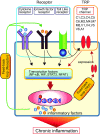"TRP inflammation" relationship in cardiovascular system
- PMID: 26482920
- PMCID: PMC4851701
- DOI: 10.1007/s00281-015-0536-y
"TRP inflammation" relationship in cardiovascular system
Abstract
Despite considerable advances in the research and treatment, the precise relationship between inflammation and cardiovascular (CV) disease remains incompletely understood. Therefore, understanding the immunoinflammatory processes underlying the initiation, progression, and exacerbation of many cardiovascular diseases is of prime importance. The innate immune system has an ancient origin and is well conserved across species. Its activation occurs in response to pathogens or tissue injury. Recent studies suggest that altered ionic balance, and production of noxious gaseous mediators link to immune and inflammatory responses with altered ion channel expression and function. Among plausible candidates for this are transient receptor potential (TRP) channels that function as polymodal sensors and scaffolding proteins involved in many physiological and pathological processes. In this review, we will first focus on the relevance of TRP channel to both exogenous and endogenous factors related to innate immune response and transcription factors related to sustained inflammatory status. The emerging role of inflammasome to regulate innate immunity and its possible connection to TRP channels will also be discussed. Secondly, we will discuss about the linkage of TRP channels to inflammatory CV diseases, from a viewpoint of inflammation in a general sense which is not restricted to the innate immunity. These knowledge may serve to provide new insights into the pathogenesis of various inflammatory CV diseases and their novel therapeutic strategies.
Keywords: Cardiovascular; Disease; Inflammasome; Inflammation; Innate immune system; TRP.
Figures


Similar articles
-
Danger- and pathogen-associated molecular patterns recognition by pattern-recognition receptors and ion channels of the transient receptor potential family triggers the inflammasome activation in immune cells and sensory neurons.J Neuroinflammation. 2015 Feb 3;12:21. doi: 10.1186/s12974-015-0239-2. J Neuroinflammation. 2015. PMID: 25644504 Free PMC article. Review.
-
New insights into TRP channels: Interaction with pattern recognition receptors.Channels (Austin). 2014;8(1):13-9. doi: 10.4161/chan.27178. Epub 2013 Dec 3. Channels (Austin). 2014. PMID: 24299922 Free PMC article. Review.
-
Cardiovascular pathobiology of inflammasomes: inflammatory machinery and beyond.Antioxid Redox Signal. 2015 May 1;22(13):1079-83. doi: 10.1089/ars.2015.6319. Epub 2015 Apr 1. Antioxid Redox Signal. 2015. PMID: 25779752 Free PMC article.
-
"Immuno-Transient Receptor Potential Ion Channels": The Role in Monocyte- and Macrophage-Mediated Inflammatory Responses.Front Immunol. 2018 Jun 6;9:1273. doi: 10.3389/fimmu.2018.01273. eCollection 2018. Front Immunol. 2018. PMID: 29928281 Free PMC article. Review.
-
Transient Receptor Potential (TRP) channels in T cells.Semin Immunopathol. 2016 May;38(3):309-19. doi: 10.1007/s00281-015-0535-z. Epub 2015 Oct 14. Semin Immunopathol. 2016. PMID: 26468011 Free PMC article. Review.
Cited by
-
Roles of transient receptor potential channels in regulation of vascular and epithelial barriers.Tissue Barriers. 2017 Apr 3;5(2):e1331722. doi: 10.1080/21688370.2017.1331722. Epub 2017 May 17. Tissue Barriers. 2017. PMID: 28581893 Free PMC article.
-
Significant contribution of TRPC6 channel-mediated Ca2+ influx to the pathogenesis of Crohn's disease fibrotic stenosis.J Smooth Muscle Res. 2016;52(0):78-92. doi: 10.1540/jsmr.52.78. J Smooth Muscle Res. 2016. PMID: 27818466 Free PMC article. Review.
-
TRPA1 inhibition ameliorates pressure overload-induced cardiac hypertrophy and fibrosis in mice.EBioMedicine. 2018 Oct;36:54-62. doi: 10.1016/j.ebiom.2018.08.022. Epub 2018 Oct 5. EBioMedicine. 2018. PMID: 30297144 Free PMC article.
-
Unlocking the potential of cardiac TRP channels using knockout mice models.Front Physiol. 2025 Apr 17;16:1585356. doi: 10.3389/fphys.2025.1585356. eCollection 2025. Front Physiol. 2025. PMID: 40313873 Free PMC article. No abstract available.
-
Substantial involvement of TRPM7 inhibition in the therapeutic effect of Ophiocordyceps sinensis on pulmonary hypertension.Transl Res. 2021 Jul;233:127-143. doi: 10.1016/j.trsl.2021.03.004. Epub 2021 Mar 7. Transl Res. 2021. PMID: 33691194 Free PMC article.
References
-
- Tousoulis D, Psarros C, Demosthenous M, Patel R, Antoniades C, Stefanadis C. Innate and adaptive inflammation as a therapeutic target in vascular disease: the emerging role of statins. J Am Coll Cardiol. 2014;63(23):2491–2502. - PubMed
-
- Virdis A, Schiffrin EL. Vascular inflammation: a role in vascular disease in hypertension? Curr Opin Nephrol Hypertens. 2003;12(2):181–187. - PubMed
-
- Golia E, Limongelli G, Natale F, Fimiani F, Maddaloni V, Pariggiano I, Bianchi R, Crisci M, D’Acierno L, Giordano R, Di Palma G, Conte M, Golino P, Russo MG, Calabro R, Calabro P. Inflammation and cardiovascular disease: from pathogenesis to therapeutic target. Curr Atheroscler Rep. 2014;16(9):435. - PubMed
-
- Ross R. Atherosclerosis--an inflammatory disease. N Engl J Med. 1999;340(2):115–126. - PubMed
-
- Ross R. The pathogenesis of atherosclerosis: a perspective for the 1990s. Nature. 1993;362(6423):801–809. - PubMed
Publication types
MeSH terms
Substances
LinkOut - more resources
Full Text Sources
Other Literature Sources

